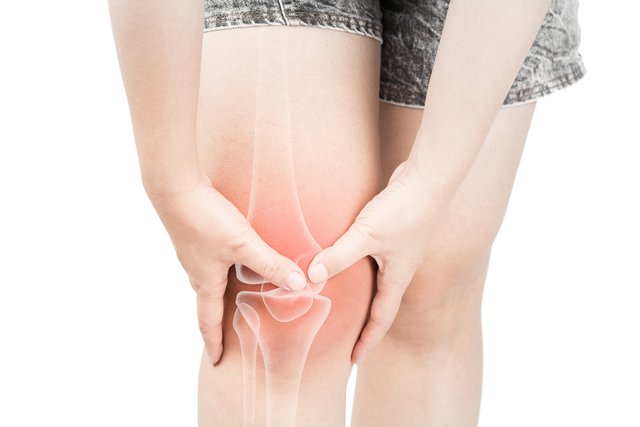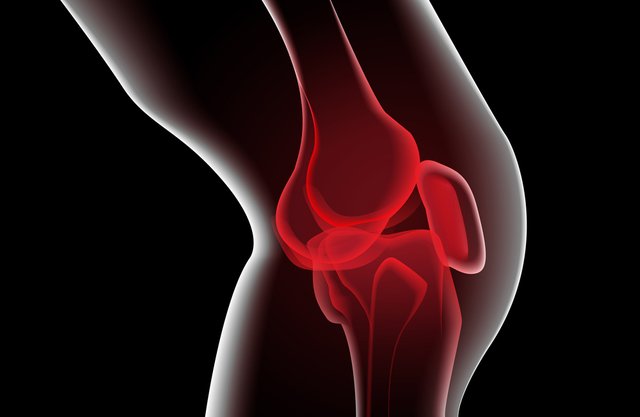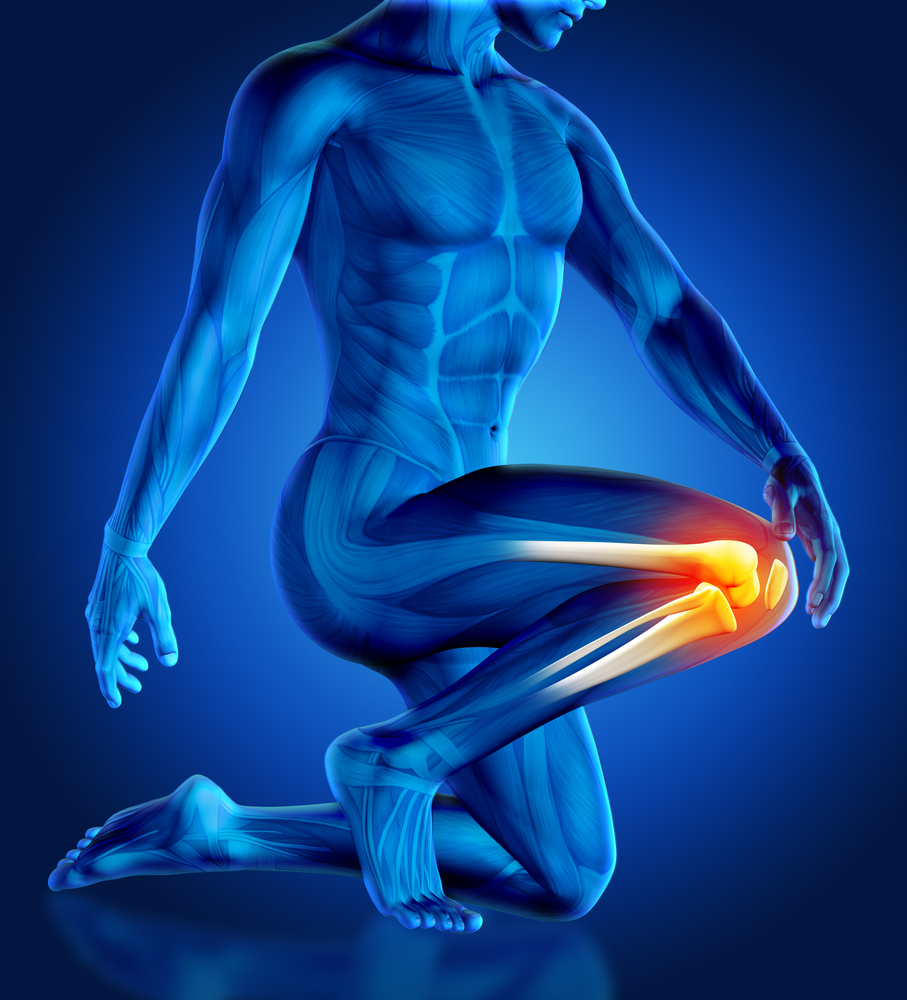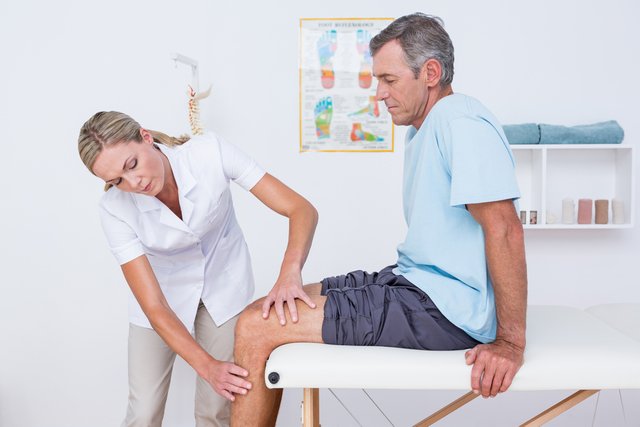Pain in knee: Cause & treatment of knee pain

Knee pain is a common condition. That's because your knee joints are moved and moved by one piece. Pain in your knee can occur in a variety of ways and thus have numerous possible causes. We therefore distinguish different types of knee complaints. The main distinction between knee pain is as follows:
- Constant knee pain ( always present)
- Functional knee complaints (with knee joint movement )
- Pain that radiates to the knee (but elsewhere arises)
- Pain injuries near the knee disc / patella / knee head / knee bolling
- Pain on the side of the knee (inside / inside or outside / outside)
- Pain in the knee cavity or knee owl
In addition, pain on the inside / inside of the knee may occur; This is also called the knee cavity or knee owl ... and on the outside / outside of the knee, also called the knee ball or knee disc. In this article we discuss the 14 most common causes of knee pain and knee pain and the related treatments...

1. Muscle pain in your knee
Muscle pain in the knees is usually caused by intensive (over) stress of the knee muscles, for example after strength training or heavy-duty work. This form of pain in your knee often involves muscle cramps in the knee cavity and pain in the upper leg muscles and calf muscles. "Ordinary" muscular pain in the knees always goes without saying. You can soften this kind of knee pain by lubricating tiger balm in your knee cavity.
2. Pain in the knee through meniscus
Menisci are cartilage discs that are loose between the bony ends of some joints. In humans there is an inner meniscus (medial meniscus) and outer meniscus (lateral meniscus) in both knee joints. These crescent shaped slices make your knee movements smooth and protect your bones.

In a sudden, unfortunate rotational movement of the knee joint, a meniscus can tear. Through such a rupture, blood and / or wound fluid can enter your knee, causing pain. This phenomenon is also called a "football bar". In a meniscus injury, your knee mainly causes pain while walking and running. In addition, pain occurs when you press the inside or outside of your knee.
A small rupture in your meniscus usually heals, but then you have to take a lot of rest. If you do not, the meniscus can further tear up, causing severe (chronic) knee injuries. In case of severe meniscus injuries, surgery is usually required to remove the damaged part of the cartilage disc.
3. Blocked knee joint = knee pain
If a piece of bone or cartilage breaks down and stays stuck between the knee joint, your knee may become "locked". You can not bend or stretch your "blocked knee". If you try to do this, you usually experience severe pain in your knee. The stuck piece of cartilage can be removed by far in most cases through a viewing operation.
A loose piece of cartilage in the knee joint usually comes from the meniscus and is also called 'joint mouse'.
4. Knee complaints by knee gland inflammation
Pain in your knee is often caused by inflammation of your knee gland. The broom in your knee acts like a pad between tendon and bone. Your knee joint allows your knee joint to move without friction or abrasion. The more frequent and intensifying your knees, the greater the chance that the mucus bust gets inflamed.
A knee gland inflammation is often caused by overload. The mucous bust can become inflamed if you exert multiple, prolonged and extremely intensive pushing, pulling or pulling on the knee joint. Your knee mucus can also be inflamed if you are extremely often on your knees; think of tilers, carpets, plumbers and streetmakers. The risk of overloading your knee slurries is extraordinary if you have weak muscles, tendons or tires in your knee joints (due to underdevelopment, wear and tear).
The most important thing you can do to prevent knee pain through your knee joint is to take a "natural" and ergonomically responsible attitude and reduce your knee strain. When the bursa in your knee still becomes inflamed, it can provide an injection of cortisol / hydrocortisone (Solu-Cortef® others) in combination with rest, compression bandage and / or punctures outcome. If the pain in the knee does not disappear, then the knee gland should usually be removed surgically.
5. Sore knee due to knee belts & crossbands
The knee joint contains four knee straps : an inner strap, an outer strap and two cross straps . These tires connect the joint parts to each other, leaving your lower leg attached to your upper leg. In addition, you provide knee belts for strengthening, protection, stability and mobility of the knee joints.
Due to an unfortunate move, fall or clap, knee injury may occur. This is especially true with an "unfortunate" jump. A knee band can stretch, tear or tear off causing severe pain in your knee. In addition to knee pain, knee swelling usually occurs, as well as blood outbreaks (bruising) and loss of function of the knee joint.
If the knee is wearable, it is good to keep careful. If you do not succeed, you should take some days to rest. Cool your knee with ice and use crutches for necessary displacement. Sometimes it may help to swallow the knee with pressure. To reduce power loss, start running again as soon as possible.
6. Knee pain due to swelling or sprains
Pain in the knee is caused by a 'sweating', 'sprains', 'twist' or 'twist' of the knee joint in many of the cases. This form of pain in the knee is caused by tires, haircuts or ligaments being stretched, for example by overload or trauma.
One speaks of a swollen or sprained knee if the faces of the knee joint are no longer stable, but still connected. Both your knee joint and your knee disc can be sprained. Knee pain by a sprained knee usually heals when the knee joint is sufficiently soured and cooled.
7. Knee dislocation causes knee pain

If there is a complete tearing of several knee tires, a "knee dislocation" may occur, resulting in extreme knee pain. This phenomenon is also known as "knee-luxation" or "getting out of the bowl" of your knee. Also, the bolling of your knee ('knee disc') may hit the bowl. If the knee disc is completely "out of the bowl", it is also known as "knee disc dislocation" or "patella-relief".
In some cases, the knee heals automatically after the disrupted part has been put back in the bowl. Often physical therapy, strength training and medication are needed to speed up recovery. If any torn knee bands do not recover properly, a knee surgery or even a half or full knee prosthesis ("artificial knee") may be required.
8. Broken knee causes knee pain
Subcutaneous tissue in your knee can be bruised by "impact" (stroke, fall, push, etc.). The consequences of a bruise often resemble those of a sprain: knee pain, swelling, bruising, etc. However, a bruise is not caused by an "unfortunate" rotation of the knee joint, but a blow to the knee. There is therefore no cracking or tearing of hairstyles, straps or ligaments.
Different tissues in your knee can pinch, including bones, muscles and connective tissues. A bruising is accompanied by an inflammatory reaction (pain, swelling, discoloration, etc.). A bruised knee goes on its own and can be treated with cold compresses. A "slight bruising" of the knee usually cures within three weeks; a "severe crush" within six weeks.
9. Bacterial knee infection can cause knee complaints
Bacterial knee infection occurs when bacteria nest and multiply in the knee joint. This causes congestion of pus in the knee, causing extreme knee pain. A bacterium can be mastered by a blemish inflammation, open injury or knee surgery. A bacteria-infected knee is usually treated with antibiotics.
10. Pain in the knee through the nerve ...
In the knee cavity there are a number of important nerves. If a nerve gets crushed, severe nerve pain in the knee joint may occur. The pain can develop in the knee cavity, but also radiate to the knee. The 'joint peroneal nerve' is relatively often the fainting of clotting. This nerve is located on the back of your femur and clears into two branches. As a result of a pinched peronal nerve in the knee, peroneal neuralgia may occur. In the vast majority of cases, there are small (peripheral) nerves in the knee. Physical therapy or manual therapy can usually result in a nerve congestion in or near the knee joint.
11. Rheumatism in your knees causes knee pain
The knees are continuously stressed and are therefore very sensitive to the development of rheumatic diseases. "Rheumatism" is a collective name for almost 200 joint diseases that are not caused by injury or accident. Of this a great deal is also commonplace. Rheumatism usually has a chronic progression: the complaints get worse as time passes. Complaints may disappear (remission), but that is relatively rare.

In rheumatoid arthritis you should think of inflammatory rheumatism (rheumatoid arthritis, etc.), joint wear (osteoarthritis / cartilage abrasion, etc.) and "rheumatoid rheumatism". Osteoarthritis is also known as "gonartrose". Rheumatism in your knees is characterized by inflammatory pain, movement pain, moisture accumulation and loss of function of the knees. In some cases, connective tissue failure (fibrosis) also occurs in the knee joint.
The knee pain does not come from the knee cancer itself , but of irritated and inflamed tires, haircuts, tendons, muscles and ligaments around it. The treatment of knee pain through rheumatism is strongly dependent on the exact species. Usually pain relievers and anti-inflammatory drugs are prescribed.
12. Knee complaints by knee injury
Pain in the knee can be caused by an injury or knee injury. The knee can be overloaded and torn. This phenomenon is relatively common with jumpers, which also means a knee injury injury known as 'jumpers knee' or 'jumpers knee'. Overload and / or tearing of the knee is also very common in (inexperienced) runners.
If the knee pain is irritated, inflamed, weakened or damaged, pressure and swelling usually occur at the top of the knee disc. In the initial stage of a knee infection or knee injury injury, there is usually a sore knee pain after intensive use of the knee. If no measures are taken, however, the pain in your knee may become chronic. Blessing of the knee can be prevented by sufficient rest, good sports shoes and overweight prevention.
Overload of the knee is also called apexitis patellae; In this case, knee complaints usually occur at the knee joint attachment to the lower leg of the knee disc.
13. A knee fracture means pain in your knee
Knee pain may occur as a result of a broken knee bone. A broken knee (lower leg / upper leg) is also known as 'knee fracture' or 'knee fracture'. Also, your knee disc can break; This is also called a "knee disc fracture" or "knee joint fracture". If a fragment of the knee disc breaks and ends in the knee joint, the knee may become "locked".
A broken knee usually occurs due to a hard fall or blow, but sometimes also by bone loss (osteoporosis). A broken knee disc should be restored. Depending on the type of rupture, a knee surgery may be required which introduces knee implants. Then a plaster band is applied. If the fragments of the knee disc are held together by tendons, tires and ligaments, the bones can grow back on their own.
14. Bone cough can cause knee pain
A cyst in the knee cavity is also called "cervical cyst" or "baker cyst". The cyst itself is usually painless and feels like a soft swelling filled with moisture. Because a cyst in most cases is caused by injury or rheumatism, a cyst can sometimes indicate the cause of a possible knee pain. A Baker-cyst or Baker's cyst in general usually disappears after the underlying cause of the knee cough is treated.
Finally

The knees are the largest joints of the human body. They are used continuously and are taxed, and therefore get very tired. The more you walk, tilt, bend, kneel and squat, the greater the risk of overload, wear, irritation and pain in your knees. The 14 above causes of knee complaints are not the only possible reasons that can cause pain in your knees. Thus, knee pain can also be caused by:
- PFPS (Patello Femoral Pain Syndrome)
- Patella- luxation
- " Running knee "
- Disease Osgood-Schlatter
- X-legs or O-legs
- Chondromalacia (rash of cranial cartilage)
Sources:
Link #1
Link #2
Link #3
Link #4
Thanks for reading, I hope you liked it!

Steem's Popularity Is Incredible!
Share the joy by inviting others!
Get More Exposure On The Chats!
It is a best way to get more exposure through private messages and in the chat rooms. These are some of the best places to get more exposure & makes Steem friends.
- Official Steemit.chat
- SteemSpeak.com @fyrstikken (24/7 Voice chat)
- Peace, Abundance, Liberty @aggroed @canadian-coconut @ausbitbank @teamsteem and More (Minnow Support Project)
For new & best authors to move forward!
http://curiesteem.com @curie
https://steemvoter.com @steemvoter @thecryptodrive @cryptomancer
My Latest Posts:
- Game Review: Forza 7 Review - More Cars than Ever!
- In the shadow of a 'forgotten war'
- Game Review: Dragon Ball Xenoverse 2 Switch Review - On the way to play Super Saiyan
- Survive - Happiness reaches you with love for yourself and for others
- Game Review: Total War Warhammer 2 Review - Treats in the footsteps of his predecessor
- Quit Smoking - Everything (A-Z) about Quitting Smoking
- The princess who slept for 100 years jacket
- Game Review: PES 2018 Review - Great in its smallness
- Cryptocurrency trading (Part 2) - Everything you need to know about crypto trading!
- Game Review: Yo-Kai Watch 2 Psychic Specters Review
- Cryptocurrency trading (Part 1) - Everything you need to know about crypto trading!
- Minecraft Story Mode Season Two Epsiode 3 Review - Jailhouse Block
- Tricopigmentation against hair loss and baldness in men


great post, thanks for sharing. Upvoted!
nice post plz upvote
Thank you for the info! I remember this the next time my knee hurts!
Nicely done mate!! Almost felt like i'm back in my orthopedics class!!
@minnowpond1 has voted on behalf of @minnowpond. If you would like to recieve upvotes from minnowpond on all your posts, simply FOLLOW @minnowpond. To be Resteemed to 4k+ followers and upvoted heavier send 0.25SBD to @minnowpond with your posts url as the memo